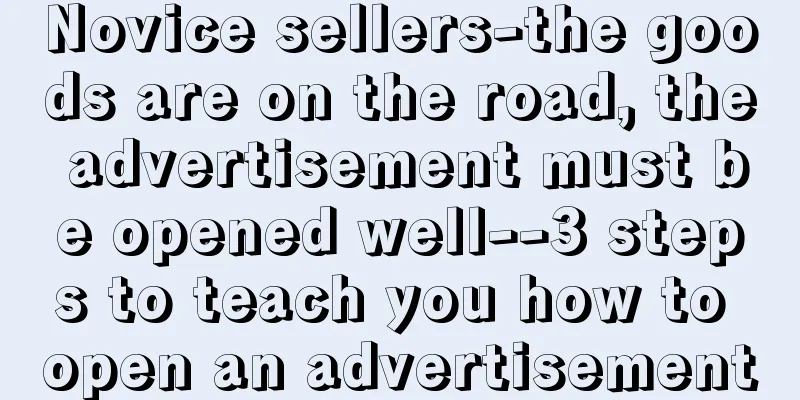Why is traffic decreasing when advertising investment doubles? Why is the Acos of a product increasing from 30% to 50% while competitors overtake it?

|
Why do our products seem to have no vitality? " What feasible paths do cross-border sellers have to improve product capabilities? Currently, the cross-border e-commerce industry has serious product homogeneity. For Chinese merchants, will micro-innovation products still be the best choice? " Zhiwubuyan Joint Validity Overseas will hold a "Product Innovation Capability White Paper" press conference in Shenzhen on November 6. This conference has invited [Mr. Ren Yu, Dean of Chaos Innovation Business School Bay Area Branch] and many important guests to share! Traffic map of the opponent The first two ads were always running. There were various matching methods in the keyword ads. I didn’t separate them at the beginning, so there were about 10 words. But what I can't understand the most is that in the 10 days from the 18th to the 28th, the traffic still dropped, and the rankings of all keywords dropped a lot. Obviously, the number of orders has increased, and the conversion rate has not changed. I want to drive the natural position of keywords through advertising, but it seems to be going in the opposite direction. Recently, I have read a lot about advertising driving natural rankings, and I saw a concept called pit production. Is it that my conversion rate is not achieved or the keyword pit production is not achieved? When the weekly report came out on the 28th, I saw that the profit loss was very large, so I reduced the budget and slightly lowered the advertising bid. So should I have persisted for a while longer? I also checked the ad positions of various campaigns. Although the top position has a better conversion rate, the bid is slightly higher. The number of orders from the other positions in the search results is similar to that of the top position, and the acos is the lowest. Then I want to move up the keyword position. Can I achieve the effect by increasing the percentage of the other positions in the search results? To sum up: there are now 2 big problems and 3 small problems in bold above.
"Wonderful Reply" My former edge has been smoothed away by life - knowledge is like the sea, and I am just a shell on the beach. Agree with: 23344, enthusiastic citizen Mr. Zhou, twin prime numbers, special people, gulugulu35 more » 1. First of all, through the traffic charts of you and your competitors, we can see that your advertising traffic and natural traffic are basically 50-50, and your competitors have obviously been advertising more aggressively recently. 2. Your automatic ads are the best performing, but your keyword ads have a very poor conversion rate, and long-tail precise keywords have the worst conversion rate. This is very abnormal. One is that competitors click on your ads, or your placement is very bad. You can observe whether your automatic ads are mainly placed in search positions or product page positions, and you will know your current best conversion position. It is not the best way to get to the top of the homepage.
Evelyn666 -A newbie Agree with: Sanbeli, Bodili, kk228, Fat Cat 001, Yawn Xiaoyu More » Learned a new knowledge (pit production): Morning breeze and waning moon Agree with: Leonardo1, Our Lady of Paris More » Judging from the traffic change graph, you did not advertise before the 7th or the intensity was relatively small, and began to increase advertising after the 7th, while your opponent has been advertising all the time and the proportion of natural traffic and advertising traffic is relatively stable. His natural traffic also began to show a significant increase on the 7th and has been maintained. Your natural traffic has been declining since the 7th, which means that the ads you added on the 7th brought a lot of junk traffic and lowered the traffic that was originally performing well. If your competitors do some other promotional actions during this period, it is easy to surpass you. This is when an ad group was originally stable, but you injected too much traffic, causing the ad group to become unstable. Once this is discovered, you must make timely adjustments and restore it to its original state. If you inject too much traffic for a long time, it will be difficult to save it. Generally speaking, if you want to increase orders, just increase the budget in the original ad group. Don't increase the budget and bid too much at once, but increase it little by little, because different budgets and bids represent different order environments and order times. Once adjusted significantly, the original order environment will be destroyed, that is, the weight of the ad group will be destroyed. If the ad weight has been disrupted for a long time, it is recommended to turn it off and restart it. Your natural traffic also increased after the 7th. This is probably because the extensive advertising brought in long-tail keyword traffic. Because too much traffic was injected, the normal natural traffic was affected, causing competitors to grab this part of the natural traffic. Then the performance within a week on the 7th was originally good, but the orders were not stable enough, so the advertising structure was adjusted again. I guess it was because the precise traffic caused by the heavy investment in traffic and the conversion of precise big keywords to extensive advertising at the beginning was diluted, and the order environment was disrupted.
two three three four four - Post-90s 996 Operation Dog Agree with: Mr. Zhou, a caring citizen, and the hard-working man who can be helped. More » There are many big names in the forum, so I would like to share my own views: First, take a look at the recent customer complaints and returns of your own advertisements, and whether there are any obvious changes in the feedback and star ratings of direct competitors. Secondly, consider whether the search popularity of the main keywords of ASIN has decreased. In fact, your organic ranking score has started to drop since the 13th. Did your competitors have better orders than you from the 13th to the 18th? You increased your advertising budget from the 18th, and the overall order volume exceeded that of your competitors. This is probably due to more orders from advertising. The actual organic conversion rate and overall conversion rate should not be as good as those of your competitors. In other words, the pit production has achieved the conversion rate but not the
Stealth Pilot - Six years of operation, welcome to communicate I took a look at the pictures you posted and noticed that in some places your overall traffic has declined sharply since mid-December. However, I see that the total traffic of your competitors is higher than yours. Is this the off-season for the market? Do you do other types of advertising? At this stage, you can use competitive product placement and SD advertising to increase conversions on product pages and other search locations. These costs are also low. As for increasing the percentage of other locations alone, I personally don’t think it has much impact (this feature was very useless when it was first released)
Enthusiastic citizen Mr. Zhou -Send Approved by: Puss in Boots If the previous link has performed well, but has fluctuated recently, it means that the link quality is OK. It's just that the market has fluctuated. The market here refers to the entire environment, including but not limited to new sellers entering the market and low-price spirals. I heard a new method that you can try. So far, the effect I have tried is still very good. Why? The advantage of this is that the keywords or ASINs in each ad group will be clicked in, and there will not be a situation where only a few ad campaigns have the most orders, and only a few ad groups in these ad campaigns have the most orders. Now it is evenly distributed.
changS Agree from: KY is getting stronger and stronger, 1easter I suggest that your first step is to classify your advertisements by type. The most basic one is to have one campaign each for broad, phrase, and precise advertising. If you mix them all together now, it will be difficult for you to control the segmentation. The same is true for ad positions. Different ad types have different main targets and different ad position performances. If you are targeting precision, you will definitely want to try to get to the top. If you are targeting broad, you may not be able to perform well at the top. Maybe your word or category performs better in other positions, but if you put them all together, once you adjust, everyone will adjust together, and you can't adjust them separately. So the overall suggestion is to divide the ad structure first and then adjust it. Anonymous user Agree with: Let the wind blow, wanfenhaoyi, Zhang Zhiming123, Heroes of the Sui and Tang Dynasties, Renshen123 My product has encountered the same problem. There is nothing wrong with the overall idea of using advertising to improve natural positioning, but there is a prerequisite: the overall conversion rate of the product must meet the standard. Jiangshan Inkstone Agree from: JosephGan I was very touched by one of the comments from the original poster (I guess it’s because if you don’t do well in the first few months after the product is launched, it will be difficult to move forward in all aspects. So some products should either give up the ranking or keep a stable mentality and don’t panic). I have compared products of different categories, and basically all of them are in this situation. If a product can get a good ranking in the early stage of its launch (the first month or two), then if there are no other unexpected problems, the product will continue to move forward.
|
Recommend
New logistics situation? How can Amazon sellers prevent warehouse delays?
Yesterday, a Canadian trade union organized a stri...
Logistics costs can no longer be suppressed! Walmart will also charge sellers for fuel
Walmart said it will charge third-party sellers ne...
Amazon and Walmart: Which company has the better logistics development?
Recently, Amazon and Walmart shared their latest p...
What is LeLiao chat++? LeLiao chat++ Review
LeLiao chat++ is an intelligent customer service s...
Made in China is under fire again, with all products removed from Amazon shelves
Recently, Amazon has removed some Chinese-made pro...
Amazon sellers’ comprehensive strategy for preparing for the 2019 peak season
Amazon has continuously broken its own sales recor...
What is MakeMytrip? MakeMytrip Review
MakeMyTrip is India's largest OTA (online trav...
AliExpress and Temu are suppressing South Korea with low prices, and local e-commerce companies are panicking
On March 25, the Fair Trade Commission (FTC) of Ko...
More than 30% of consumers plan to cut spending, and this year's US shopping season may be particularly cold
It is learned that according to the latest survey ...
Why did Amazon store sales suddenly drop? Sellers can check these 10 reasons!
text Why did the sales of my Amazon store product...
Shocked! Amazon sellers actually celebrated National Day like this...
Although Amazon people do not have absolute holid...
What is Depop? Depop Review
Depop is a British fashion shopping platform where...
What is Byju's? Byju's Review
Byju's is an Indian K12 online education servi...
What is Amazon Care? Amazon Care Review
The virtual health care service will be available ...
Big Commerce and Mercado Libre reach cooperation! Officially enter the Latin American market
<span data-shimo-docs="[[20,"获悉,Big Commer...









